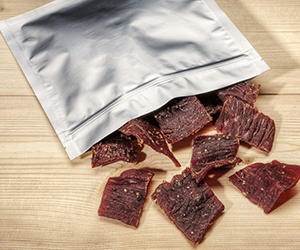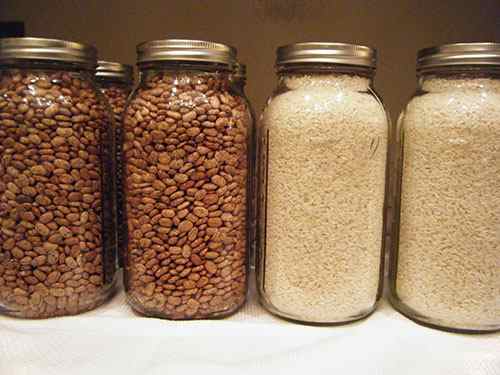If you’re like most preppers you probably have a pretty wide assortment of food stashed away. My own supply contains everything from MREs and freeze-dried camping meals to sacks of bulk rice, there are dozens of different items in there. My guess is that your own stockpile is pretty much the same – and that makes sense. A wide variety of food won’t just help you put together nutritionally balanced meals after the SHTF, it’ll keep your diet more interesting and enjoyable, too.
What if you couldn’t have all this variety, though? What if you were only able to stockpile, say, ten or twelve items? Which ones would you choose then? I read an article about this a couple of weeks ago and got to thinking about it, and it was an interesting exercise. In the process, I realized it was more than just interesting, though – it could be useful, too.
It’s easy to go for variety if, like a lot of people, you build up your reserves by adding a couple extra cans and packets to your grocery cart every week. On the other hand, the cheapest and most efficient way to stockpile food is to buy it in bulk, and once you start doing that you need to focus on fewer items unless money and space aren’t limiting factors (and, for most of us, they are).
You can build up a large stockpile faster and more cheaply if you pick a few items and buy them in bulk quantities. Of course, you need to pick the right items, because it’s important to still have a balanced diet – the cheapest solution of all would be to just order a few hundred-pound sacks of rice, but that wouldn’t just get boring in a hurry; you’d be missing a lot of essential nutrients as well.
On the other hand, with a list of ten items, you can still buy in bulk and also have enough options to put together a balanced diet. The article I was reading attempted to do this, but some of the food choices were… unusual, to say the least. Nutritionally it all made a lot of sense, but the key thing about a survival food supply is it needs to be nutritious foods you can store. Whatever you think of broccoli, it isn’t famous for its long shelf life, so I decided to make up my own list to see if, restricted to just ten foods, I could do better. I think I did.
Related Article: How to Preserve and Store the Harvest
#1. Sauerkraut


Properly canned sauerkraut will last for several months, at least – but if you store it in a cool root cellar, and do some basic food safety checks when you open the jar, my experience is that it’s good for a couple of years at least. In the days of sail, ships loaded barrels of it to protect the crew from scurvy on voyages that could last for years. Every year, when we harvest the cabbages from our vegetable lot, a new batch of sauerkraut goes to the back of the shelves.
#2. Jerky


Secondly, jerky will last a long time if it’s dry enough and properly packed. Vacuum pack it in mylar bags with an oxygen absorber, and it should stay good for years. Jerky is also versatile. It can be soaked and added to soups, stews or other dishes to add protein and flavor, or it can be carried as a lightweight snack when you’re on the move.
The one downside of jerky is that it’s expensive to buy, but it’s easy enough to make your own. All you need is a dehydrator or a drying rack and a screen to keep insects off. I have a light wooden frame with racks inside and a covering of door screen mesh; it lets air circulate, but keeps bugs off the drying meat.
#3. Beans
Dried beans are already a staple of most preppers’ food reserves. They can be stored for years, and let you make a wide range of filling dishes. They’re great for bulking out soups and stews. Beans are also a good source of protein, which is unusual for a vegetable, as well as fiber.
Beans are a good candidate for bulk buying. A pound of pinto beans will cost you about $1.50, but Walmart will sell you a 20-pound bag for less than $15.


#4. Rice
Another prepper favorite, rice is the staple food for over half of the human race. A fifth of all calories eaten in the world is rice. As you can probably guess from that it’s a great source of carbohydrates – and a survival situation is not the place for a low-carb diet. Rice is just as versatile as beans and can be cooked in many different ways. On top of that, if you combine rice and beans you get a complete protein – the combination contains all the amino acids your body needs.
Rice is also available from Walmart in 20-pound sacks, and one of these will cost you just $8.43.
#5. Lard


Lard is tasty, packed with energy, and rich in essential fatty acids. It can also be stored for a long time without going rancid – most people will say a few months without refrigeration, but the reality is that lard in a sealed container will last for years. You can make your own lard by rendering and straining pork fat, so if you keep pigs there’s an obvious use for that belly fat.
Lard is also pretty cheap to buy. A four-pound pail will cost you less than $7; for storage and convenience, melt it and can it in smaller jars.
#6. Potato Flakes


Potato flakes are just boiled mashed potato that’s been dried and crushed. Mixing them into boiling water will give you instant mashed potatoes; they can also be used for baking and to thicken soups and stews. RealFoods will sell you 220 pounds of potato flakes for under $130, but I make my own; all you need to do is make mashed potato, without adding any milk or butter, then spread it thinly on sheets and put them in the dehydrator. Then I break up the dried sheets of potato, give it a couple of seconds in the blender, and vacuum pack the flakes.
#7. Sugar


#8. Tomato Paste


You can get tomato paste in large cans, but as you probably won’t use much at a time you risk losing a lot to spoilage. The acid in tomatoes also reduces the shelf life of the cans. This is one time when you’re probably better buying it in smaller tubes, but you can save money on multipacks. A pack of six 4.5-ounce tubes costs around $12. You can also make your own.
Related Article: The Proper Way of Canning Tomatoes
#9. Milk Powder


Dry milk is another expensive item, and this isn’t one you can make yourself without some expensive equipment, so again it’s a lot better to buy it in bulk. You can get a four-pound bag for around $16 at Walmart.
#10. Powdered Eggs


Whole egg powder isn’t cheap, but you get a lot of calories and protein for your money. A six-gallon tub costs around $200 from Augason Farms, or you can get four gallons for $115 in Walmart. If you have chickens and a dehydrator you can also make your own.
As I said, I have a lot more than ten items in my food reserve – this was a thought exercise more than anything else. It did throw up some good ideas, though. If you could only stockpile ten food items, what would they be?





















